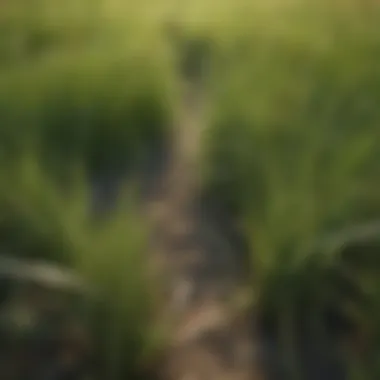Tall Fescue Weed Identification Guide


Intro
Tall fescue, a perennial grass species, is prized for its resilience and adaptability in various environmental conditions. However, when it becomes a weed in agricultural areas, it poses challenges for production and management. Understanding tall fescue's characteristics and growth habits is essential for effective identification and management.
Topic Overview
Definition of Key Terms
To begin, let’s define a few key terms related to tall fescue and weed identification:
- Tall fescue: A deep-rooted grass species known for its drought resistance and tough growth habits, widely used in pastures and lawns.
- Weed: A plant deemed undesirable in a particular context; it competes with crops and desirable plants for nutrients, water, and light.
- Identification: The process of distinguishing plants based on specific characteristics such as leaf shape, growth pattern, and habitat.
Relevance in Agriculture, Horticulture, and Agronomy
Tall fescue can thrive in various climates and soil types. While it has benefits such as erosion control, it can also become dominant in fields where it is not wanted. This is particularly relevant in agricultural settings, where crops can suffer from reduced yield and quality if tall fescue is left unchecked. Proper identification is thus paramount for farmers and agronomists who seek to maintain productivity and soil health.
Current Trends and Innovations
Recent Advancements in the Field
The knowledge surrounding tall fescue has evolved significantly, with recent studies focusing on its growth patterns and competitive behaviors. Research indicates that varieties of tall fescue can have differing impacts on biomass production.
Emerging Technologies and Practices
Innovative technologies, such as precision agriculture tools, enhance identification capabilities. Drones equipped with imaging technology can help pinpoint tall fescue infestations across expansive fields. This allows for targeted management interventions, which minimizes resource use and maximizes effectiveness.
Practical Applications
Step-by-Step Guides or How-Tos
Identifying and managing tall fescue requires a structured approach. Here’s a step-by-step guide:
- Observe growth patterns: Tall fescue typically grows in tufts and can reach heights of 2-3 feet, with a characteristic coarse leaf texture.
- Examine leaves: Look for dark green, broad leaves that may appear shiny. The leaf shape is lanceolate, and the base is often rolled.
- Check seeds: When reproductive, the seed heads have a distinctive drooping appearance. They are borne on racemes, which can appear light and airy.
Tips and Best Practices for Implementation
- Regular monitoring of fields for early detection of tall fescue.
- Implement rotational grazing to prevent its establishment in pastures.
- Use herbicides selectively, targeting tall fescue while protecting desirable crops.
"Effective management begins with accurate identification. Understanding tall fescue's behavior is crucial in preserving agricultural productivity."
Understanding Tall Fescue
Tall fescue (Festuca arundinacea) is an important perennial grass species, particularly in agricultural settings. The understanding of this weed is crucial because it directly affects crop yields and ecological balances in various environments. Recognizing tall fescue helps in effective farm management, allowing farmers to take informed decisions that can mitigate its undesirable impact.
Botanical Classification
Botanically, tall fescue belongs to the Poaceae family, which encompasses a wide variety of grass species. Within this classification, tall fescue is known for its unique characteristics, such as its coarse leaves and deep root system. The plant can be differentiated from other grasses due to its specific genetic traits, such as its chromosome number. Understanding these traits proves essential in identifying tall fescue effectively.
Growth Habits
Tall fescue demonstrates unique growth habits that contribute to its success as a weed. It tends to thrive in diverse soil types and can endure a range of weather conditions. This adaptability allows it to spread quickly, often outcompeting desirable crops for nutrients, water, and light. The grass grows in clumps, producing dense mats that can shade out other plant life. Recognizing these growth habits is fundamental for implementing control measures on farmland.
Ecological Role
In an ecological context, tall fescue plays a dual role. On one side, it offers certain ecological benefits, such as erosion control and habitat for various organisms. On the other side, it often interferes with the growth of native plants, leading to reduced biodiversity. It's vital to understand this balance. While tall fescue may aid in some ecological functions, its aggressive nature can lead to significant challenges in maintaining healthy ecosystems. Knowing this role aids farmers and land managers in making balanced decisions regarding their land and crop management.


Understanding tall fescue is crucial for recognizing its impacts and managing its growth in agricultural systems effectively.
Identifying Tall Fescue
Identifying tall fescue is a critical aspect of managing this grass effectively, especially in agricultural landscapes. It allows farmers and land managers to make informed decisions regarding plant health and control measures. Understanding its characteristics can help in distinguishing it from desirable grass species and other weeds. This knowledge is essential for implementing appropriate management strategies and optimizing land use.
Morphological Features
Leaf Structure
The leaf structure of tall fescue is one of its distinct features. The leaves are long, narrow, and can be either smooth or slightly coarse. They often have a prominent midrib, which is a common characteristic. This trait provides several benefits. First, the leaves can photosynthesize efficiently, promoting strong growth. Moreover, their durability makes tall fescue a suitable choice in various climates.
However, the leaf structure can also present challenges. For instance, the toughness of the leaves may deter grazing animals, affecting pasture management.
Stem Characteristics
Tall fescue stems are another important aspect for identification. They are typically erect, strong, and can reach considerable height. This arises from their robust growth habit. The stems' strength allows tall fescue to withstand certain environmental stresses, such as wind and heavy rainfall.
A unique feature of these stems is their ability to form a dense, fibrous mat near the base. This mat can lead to competition with surrounding plants. Understanding this characteristic aids in recognizing potential issues in mixed plantings.
Seed Head Appearance
Seed head appearance is crucial when identifying tall fescue. The seed heads develop in a characteristic spike formation, which usually contains multiple florets. This distinctive shape makes them easily recognizable. The potential for prolific seed production contributes to the spread of tall fescue, making it more challenging to control as a weed.
However, seed head appearance can also offer insights into the plant's maturity and viability. Observing these seed heads can assist in assessing whether control measures are necessary.
Growth Stages
Germination
Germination marks the start of tall fescue's life cycle. This stage is important, as it greatly influences overall plant establishment. The seeds require adequate moisture and warmth for successful germination. Under ideal conditions, germination occurs swiftly, allowing for rapid colonization of available space.
However, prolonged dry spells can hinder this process, affecting the plant’s growth potential.
Vegetative
The vegetative stage is characterized by rapid growth and leaf expansion. During this phase, tall fescue develops a strong root system, vital for capturing nutrients and water. This growth pattern is beneficial, allowing the plant to outcompete other grasses and weeds.
However, intense competition could result in overcrowding, impacting the quality of forage produced in pastures.
Reproductive
The reproductive stage signifies a transition within tall fescue’s life cycle. At this point, the plant focuses energy on flowering and seed production. This stage is crucial for the species' dispersal, impacting land management decisions.
While it ensures the survival of the species, excessive seed production can lead to further spread in unwanted areas, causing issues in crop fields or pasture.
Seasonal Variability
Seasonal variability affects tall fescue growth and management practices. In early spring, the plant awakens and begins growth, often outpacing many other grasses. This early growth can be advantageous for farmers seeking to maximize yields during the growing season.
However, tall fescue may also show decline in extremely hot summer months. During this time, it can enter a dormant phase, reducing competition with other plants. Understanding these seasonal patterns is key in planning effective management strategies.
Effective identification and management of tall fescue can lead to improved crop yields and pasture health.
Distinguishing Tall Fescue from Desirable Grasses
Identifying tall fescue accurately is pivotal for anyone engaged in agriculture, especially in grassland management. This section emphasizes various factors that underscore the necessity of distinguishing tall fescue from desirable grasses. Understanding these differences can prevent economic losses and enhance land management strategies. Knowing how to differentiate between desirable grasses and the tall fescue can inform decisions about pasture renovation, crop rotation, and weed management practices, thereby maintaining healthy ecosystems.


Comparative Features
Closely Related Species
The tall fescue can sometimes be confused with similar species like Kentucky bluegrass or perennial ryegrass. Each of these grasses has specific characteristics that make them more suitable for particular environments. For instance, Kentucky bluegrass is known for its lush growth and is often chosen for lawns and parks, providing a soft touch underfoot. In contrast, tall fescue holds a key characteristic of being drought-resistant, allowing it to thrive in dry conditions where other grasses may fail. Understanding the unique adaptations of closely related species can provide insights into their respective roles in an ecosystem.
"Recognizing differences among grass species can significantly influence effective management strategies across agricultural landscapes."
Native vs. Invasive Traits
The distinction between native and invasive traits plays a crucial role in assessing the impact of tall fescue in any given environment. Native species, such as fine fescue, promote biodiversity and support ecological balance, while tall fescue can sometimes behave as an invasive species, out-competing native flora. The invasive nature of tall fescue can lead to reduced habitat for local wildlife and challenges in maintaining local biodiversity. Recognizing these traits can help land managers and farmers adopt better practices that favor native species, promoting a healthier ecosystem overall.
Visual Identification Techniques
Visual identification is a fundamental skill for effective weed management. Observers should focus on key aspects such as leaf shape, color, and growth habit when determining if they are looking at tall fescue or a desirable grass type. For example, tall fescue often has broad, dark green leaves compared to the finer textures of many native grasses. Using a magnifying glass may help in observing minute details like seed heads or leaf margins, which can aid in accurate identification. Understanding these visual markers enhances one’s ability to make informed agronomic decisions.
The Impact of Tall Fescue as a Weed
Understanding the impact of tall fescue as a weed is crucial for those in agricultural sectors. It presents several challenges, especially regarding crop productivity and ecological balance. This section examines the agricultural and ecological concerns related to tall fescue’s invasive nature. We will discuss how both competition with crops and nutrient cycling relating to tall fescue affect farming practices.
Agricultural Implications
Competition with Crops
Competition with crops is a significant concern when it comes to tall fescue. It tends to dominate the space intended for crops, leading to reduced yields. Farmers often notice that their staple crops suffer when tall fescue becomes established. The key characteristic of tall fescue in this context is its aggressive growth habit. This prevents crops from getting adequate sunlight and nutrients. Since tall fescue has a deep root system, it can access water and nutrients not reachable by shallower-rooted crops.
The unique feature of this competition is the fact that tall fescue can thrive in various conditions, making it a resilient weed. Its adaptability can be both an advantage and a disadvantage. On one hand, it provides some ground cover that can prevent erosion. On the other hand, it often results in a lower yield for crops such as corn and soybeans. Effectively managing tall fescue alongside crops is therefore critical to maintain profitable agricultural operations.
Nutrient Cycling Effects
Nutrient cycling effects pertain to how tall fescue influences the availability of essential nutrients in the soil. It has the potential to either enrich or deplete soil nutrients depending on various factors like density and growth stage. One key characteristic of tall fescue is its ability to establish a dense network of roots that can alter soil composition. This can lead to competition for nutrients among crops.
The unique feature of nutrient cycling with tall fescue is its capacity to retain nitrogen in the soil, which can be beneficial in some circumstances. However, if tall fescue becomes too dominant, it can limit nutrient uptake for surrounding crops, negatively impacting their health. Thus, understanding these dynamics is vital for farmers looking to optimize soil health and crop productivity.
Ecological Concerns
Biodiversity Impacts
Tall fescue’s growth often leads to biodiversity impacts in agricultural and natural ecosystems. Its dominance can result in a decline in plant species that are less competitive. The key characteristic here is its capacity to outcompete local flora, which can disrupt local ecosystems. This shift reduces the variety of plants and animals in the area, leading to a decline in ecological resilience.
The unique feature of tall fescue’s impact on biodiversity serves as a double-edged sword. While providing some benefits like cover for certain ground-nesting species, it can present significant risks to native plants and their associated fauna. Preserving biodiversity is essential for maintaining ecosystem health, so tall fescue management strategies should focus on minimizing its spread.
Habitat Alteration
Habitat alteration occurs when tall fescue modifies the physical environment in which it grows. This includes changes to soil structure, moisture levels, and light availability that can affect both plants and animals. The key characteristic of tall fescue here is its capacity to create environments that may seem suitable for its growth but are detrimental to other species.
The unique feature of habitat alteration by tall fescue involves its ability to thrive in disturbed areas, such as degraded pastures. While it can provide some immediate ground cover, this often comes at the cost of displacing local species. Addressing habitat alteration is crucial for maintaining ecological balance within agricultural landscapes. Managing tall fescue effectively can help restore native habitats and maintain agricultural productivity.
Management Strategies for Tall Fescue
Managing tall fescue effectively is crucial for mitigating its impact as a weed in agricultural systems. These management strategies aim to reduce its proliferation while promoting the overall health of desirable crops. Each strategy can significantly enhance soil health, crop yields, and ecosystem stability. Understanding and implementing effective management is vital, particularly for farmers and enthusiasts striving to maintain the integrity of their fields.
Mechanical Control
Mechanical control involves physical methods to manage tall fescue populations. These methods require less reliance on chemicals and can be more sustainable over the long term.
Mowing Practices


Mowing is a common mechanical practice used to manage tall fescue. By cutting the grass before it reaches the seed head stage, farmers can limit its ability to reproduce. The key characteristic of this method is its straightforwardness. It does not involve chemical application, which can be appealing to those cautious of herbicides.
However, mowing must be timed correctly for it to be effective. Early and consistent mowing can reduce the vigor of tall fescue and lower its competitive advantage. One potential disadvantage is that this method requires regular scheduling. Neglecting the mowing schedule may allow tall fescue to flourish, potentially leading to increased seed bank viability.
Tillage Methods
Tillage is another mechanical technique, where the soil is turned over to disrupt the root system of tall fescue. The main advantage of tillage is that it can eliminate tall fescue plants from the soil. It is especially effective when implemented in the early spring or fall when the plants are most vulnerable.
One distinctive feature of tillage is its ability to prepare the seedbed for subsequent crops. However, it may also lead to soil erosion and loss of beneficial soil structure if overused. Therefore, farmers need to balance tillage practices with soil conservation strategies.
Chemical Control
Chemical control provides a different set of tools to manage tall fescue effectively. Herbicides are a notable component of this strategy, delivering targeted and efficient results.
Herbicides Overview
Herbicides are chemical formulations designed to kill unwanted plants, including tall fescue. They can quickly reduce populations when applied correctly. The noteworthy aspect of this method is its effectiveness in large areas, making it a popular choice among farmers with extensive land.
However, the selection of herbicides needs careful consideration. There are systemic and contact herbicides, each with unique characteristics. One critical disadvantage is the potential for resistance development in tall fescue populations if herbicide application is not managed prudently. Farmers should rotate herbicides with different modes of action to mitigate resistance risks.
Application Techniques
Proper application techniques are essential for maximum efficacy of herbicides. This process includes choosing the right timing, setting the correct spray width, and considering environmental conditions, like wind and humidity. The key characteristic of application techniques is precision, which ensures that herbicides are targeted effectively without harming desirable plants.
On the downside, improper application can lead to misapplication, resulting in poor control of tall fescue and potential damage to surrounding crops. Hence, training and adherence to guidelines are crucial in implementing this strategy effectively.
Integrative Management Approaches
Integrative management approaches combine various methods to achieve a more versatile strategy in addressing tall fescue as a weed. This strategy allows for more sustainable agriculture practices.
Crop Rotations
One method is crop rotation, where different types of crops are grown in successive seasons. This practice disrupts the life cycle of tall fescue and reduces its establishment in subsequent years. The notable feature of crop rotations is their ability to enhance soil health and biodiversity, minimizing the need for chemical inputs.
Nevertheless, it requires planning and knowledge about the compatibility of different crops. If not planned well, the transition between crops can potentially lead to short-term yields decline while the system stabilizes.
Cover Cropping
Cover cropping involves planting crops that cover the soil between main crops. This method can suppress tall fescue growth by outcompeting it for resources. The unique characteristic of cover cropping is that it improves soil health, enhances moisture retention, and promotes biodiversity.
Despite its benefits, cover crops also require a proper selection of species and management. Not all cover crops are effective against tall fescue, and monitoring their interaction is vital to ensure successful suppression.
By integrating these strategies, farmers can create a more resilient agricultural system, enhancing sustainability and promoting crop productivity.
Culmination
The conclusion of this article emphasizes the significant role of understanding tall fescue in agricultural settings. Recognizing this perennial grass weed is crucial for farmers and enthusiasts who seek to maintain healthy crops and pastures. Given its capacity to compete with cultivated species, effective identification and management strategies can save resources and enhance crop yields.
Future Research Directions
There is a growing necessity for further research into tall fescue and its interaction with various agricultural ecosystems. Key areas to explore include:
- Genetic Diversity: Understanding the genetic variations among tall fescue populations can help in breeding programs aimed at creating more competitive crops.
- Interactions with Soil Microbiomes: Investigating how tall fescue affects soil health and microbial communities may lead to better soil management practices.
- Response to Climate Change: As global temperatures rise, studying how tall fescue adapts to environmental changes can inform future agricultural resilience.
- Integrated Pest Management (IPM): Understanding how pests interact with tall fescue can enhance integrated management strategies.
Future studies in these areas could provide valuable insights that not only improve the management of tall fescue but also contribute to sustainable agricultural practices.
Key Takeaways
In summary, here are the key points highlighted throughout the article:
- Tall fescue is a resilient weed that can significantly impact agricultural productivity.
- Accurate identification is essential to differentiate it from desirable grass species.
- Understanding its growth habits and ecological role helps devise effective management practices.
- Future research is crucial for developing advanced strategies that mitigate its effects on crops.
Farmers and agricultural enthusiasts should prioritize learning about tall fescue. By doing so, they enhance their capacity to make informed decisions, ultimately leading to better management of their lands.



